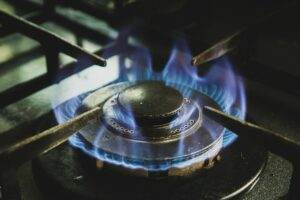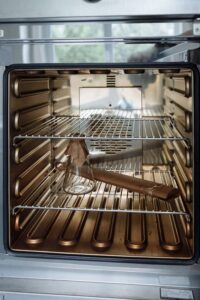A dishwasher is an essential appliance in any kitchen, designed to make our lives easier by automating the process of washing dishes. It saves us time and effort, allowing us to focus on other tasks while it takes care of the dirty dishes. However, there are times when a dishwasher may not complete its cycle, leaving us with partially cleaned dishes and a frustrating situation.
When we say that a dishwasher does not complete its cycle, it means that it stops before finishing the entire washing, rinsing, and drying process. This can happen for various reasons, such as blockages in the dishwasher’s system, malfunctioning components, or issues with the water supply or drainage. It is important to address this issue immediately to ensure that your dishwasher continues to function properly and efficiently.
Key Takeaways
- Dishwasher not completing cycle can be caused by various factors
- Blockages in the dishwasher can prevent it from completing the cycle
- Inspecting the spray arm can help identify issues with the dishwasher
- Testing the heating element and water inlet valve can also help troubleshoot the problem
- Regular maintenance and cleaning can prevent dishwasher not completing cycle issues in the future
Common Causes of Dishwasher Not Completing Cycle
There are several common reasons why a dishwasher may not complete its cycle. One of the most common causes is a blockage in the dishwasher’s system. This can occur in the drain hose, the spray arm, or the water inlet valve. When there is a blockage, water cannot flow freely through the dishwasher, causing it to stop mid-cycle.
Another common cause is a malfunctioning spray arm. The spray arm is responsible for distributing water throughout the dishwasher to clean the dishes effectively. If it is damaged or clogged with debris, it may not be able to rotate properly and distribute water evenly, resulting in an incomplete cycle.
The heating element is another component that can cause a dishwasher to not complete its cycle. The heating element is responsible for drying the dishes at the end of the cycle. If it is faulty or not functioning correctly, the dishwasher may stop before completing the drying process.
How to Check for Blockages in the Dishwasher
To check for blockages in your dishwasher, you will need to follow a few simple steps. First, make sure the dishwasher is turned off and unplugged. Then, remove the bottom rack to access the drain area. Look for any debris or food particles that may be blocking the drain. Use a soft brush or cloth to remove any blockages.
Next, check the spray arm for any blockages. Remove it from the dishwasher and inspect it for debris or clogs. If you find any, clean it thoroughly with warm water and a brush to remove the blockages.
Finally, check the water inlet valve for any blockages. This valve controls the flow of water into the dishwasher. If it is clogged, water may not be able to enter the dishwasher properly, causing it to stop mid-cycle. To check the water inlet valve, turn off the water supply to the dishwasher and disconnect the inlet hose. Inspect the valve for any debris or blockages and clean it if necessary.
How to Inspect the Dishwasher’s Spray Arm
The spray arm plays a crucial role in the dishwasher’s cleaning process. It is responsible for distributing water throughout the dishwasher to clean the dishes effectively. If it is damaged or clogged with debris, it may not be able to rotate properly and distribute water evenly, resulting in an incomplete cycle.
To inspect the spray arm, start by removing it from the dishwasher. Depending on your dishwasher model, you may need to unscrew it or simply lift it out of its position. Once removed, inspect it for any cracks, breaks, or clogs. If you find any debris or blockages, clean it thoroughly with warm water and a brush.
If you notice any damage to the spray arm, such as cracks or breaks, it may need to be replaced. Contact your dishwasher manufacturer or a professional technician for assistance in finding and installing a new spray arm.
How to Test the Dishwasher’s Heating Element
The heating element is responsible for drying the dishes at the end of the dishwasher cycle. If it is faulty or not functioning correctly, the dishwasher may stop before completing the drying process. To test the heating element, you will need a multimeter.
Start by turning off the power to the dishwasher and unplugging it. Locate the heating element, which is usually located at the bottom of the dishwasher tub. Disconnect the wires connected to the heating element and set your multimeter to the resistance or ohms setting.
Touch one probe of the multimeter to each terminal of the heating element. If the multimeter reading shows infinite resistance or no continuity, it means that the heating element is faulty and needs to be replaced. If the reading shows a low resistance or continuity, it means that the heating element is functioning properly.
How to Check the Dishwasher’s Water Inlet Valve

The water inlet valve controls the flow of water into the dishwasher. If it is clogged or damaged, water may not be able to enter the dishwasher properly, causing it to stop mid-cycle. To check the water inlet valve, you will need to turn off the water supply to the dishwasher and disconnect the inlet hose.
Once you have disconnected the inlet hose, inspect the valve for any debris or blockages. Clean it thoroughly with warm water and a brush if you find any blockages. If you notice any damage to the valve, such as cracks or leaks, it may need to be replaced. Contact your dishwasher manufacturer or a professional technician for assistance in finding and installing a new water inlet valve.
How to Inspect the Dishwasher’s Drain Pump
The drain pump is responsible for removing water from the dishwasher at the end of each cycle. If it is damaged or clogged with debris, water may not be able to drain properly, causing the dishwasher to stop mid-cycle. To inspect the drain pump, start by turning off the power to the dishwasher and unplugging it.
Locate the drain pump, which is usually located at the bottom of the dishwasher tub. Remove any screws or clips that are holding it in place and disconnect the wires connected to the pump. Inspect the pump for any debris or blockages and clean it thoroughly with warm water and a brush.
If you notice any damage to the drain pump, such as cracks or leaks, it may need to be replaced. Contact your dishwasher manufacturer or a professional technician for assistance in finding and installing a new drain pump.
How to Test the Dishwasher’s Timer or Control Board
The timer or control board is responsible for controlling the various functions and cycles of the dishwasher. If it is faulty or not functioning correctly, the dishwasher may stop before completing its cycle. To test the timer or control board, you will need a multimeter.
Start by turning off the power to the dishwasher and unplugging it. Locate the timer or control board, which is usually located behind the control panel of the dishwasher. Disconnect any wires connected to the timer or control board.
Set your multimeter to the resistance or ohms setting and touch one probe of the multimeter to each terminal of the timer or control board. If the multimeter reading shows infinite resistance or no continuity, it means that the timer or control board is faulty and needs to be replaced. If the reading shows a low resistance or continuity, it means that the timer or control board is functioning properly.
How to Troubleshoot Dishwasher Not Completing Cycle
To troubleshoot a dishwasher not completing its cycle, you will need to follow a systematic process to identify the root cause of the issue. Start by checking for any blockages in the dishwasher’s system, such as in the drain hose, spray arm, water inlet valve, or drain pump. Remove any blockages you find and clean these components thoroughly.
Next, inspect the dishwasher’s heating element, spray arm, water inlet valve, and drain pump for any damages. If you notice any cracks, breaks, or leaks, these components may need to be replaced.
If all the components appear to be in good condition and there are no blockages, you may need to test the dishwasher’s timer or control board using a multimeter. If the timer or control board is faulty, it will need to be replaced.
Preventive Measures to Avoid Dishwasher Not Completing Cycle
To prevent a dishwasher from not completing its cycle, there are several preventive measures you can take. First, make sure to scrape off any excess food from your dishes before placing them in the dishwasher. This will help prevent blockages in the system.
Regularly clean and maintain your dishwasher by running a cleaning cycle with a dishwasher cleaner or vinegar. This will help remove any built-up residue or debris that can cause blockages or affect the dishwasher’s performance.
Check and clean the dishwasher’s filter regularly. The filter is responsible for trapping food particles and debris to prevent them from clogging the system. If the filter is dirty or clogged, it can affect the dishwasher’s performance.
In conclusion, a dishwasher not completing its cycle can be a frustrating issue to deal with. However, by following the steps outlined in this article, you can troubleshoot and address the issue effectively. It is important to check for blockages in the dishwasher’s system, inspect components such as the spray arm, heating element, water inlet valve, and drain pump for any damages or blockages, and test the timer or control board if necessary.
Preventive measures such as regular cleaning and maintenance can also help avoid a dishwasher not completing its cycle. By taking these steps and seeking professional help if needed, you can ensure that your dishwasher continues to function properly and efficiently, saving you time and effort in the kitchen.
If you’re struggling with a dishwasher that isn’t completing its cycle, you’ll want to check out this informative article on 911 Appliance’s blog. They provide a comprehensive guide on diagnosing and finding solutions for this common issue. From troubleshooting tips to potential repairs, this article has got you covered. Don’t let a malfunctioning dishwasher ruin your day – click here to read the article and get your appliance back in working order.
What Are the Possible Reasons for a Dishwasher Not Completing Its Cycle?
Some common dishwasher problems symptoms include the dishwasher not completing its cycle. This could be due to a faulty timer, a clogged drain, or a malfunctioning water inlet valve. It’s also possible that there is an issue with the motor or the heating element. In addition to these issues, you may encounter dishwasher filling issues explained by a blocked float switch or a malfunctioning pressure switch. These components are essential for regulating the water level, and if they fail, your dishwasher may not fill properly. Addressing these problems promptly can prevent further damage and ensure that your dishwasher operates efficiently.



